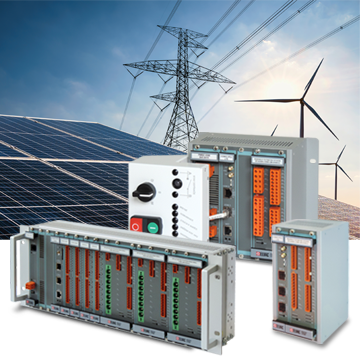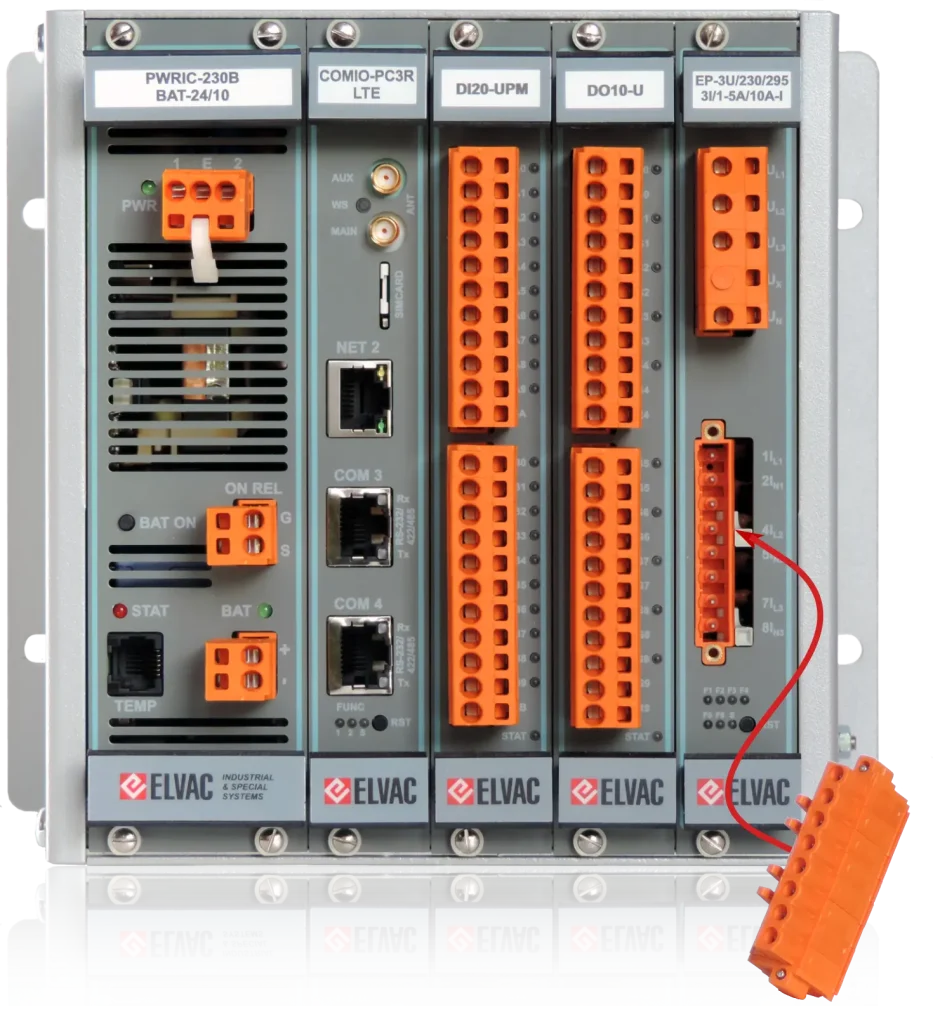Modular RTU by ELVAC are devices for remote monitoring, control, measurement and data acquisition in many fields of industrial automation, especially in the power industry.
The modular concept allows any system configuration to be tailored to the application, from small systems to large systems with hundreds to thousands of inputs and outputs consisting of many units that appear as a single system.
Over many years of development in collaboration with our system users, we have equipped our systems with many sophisticated, high value-added features that allow us to solve given types of applications with a single device rather than many intricately interconnected devices with problematic compatibility and different software features. By using these our integrated features, the whole system can be much more efficient in terms of cost, reliability, ease of system design, deployment and maintenance. We also offer systems that are fully compliant with cybersecurity requirements.
For a better understanding and easier real use of our systems, in addition to extensive documentation, we also offer training for users and quality technical support, thanks to which we manage to keep expanding our satisfied users in different countries of the world.

- Each I/O card in RTU7M has its own processor. The system performance is therefore not limited by the power of a single processor. All information is transmitted to the communication card, which mediates the data to the higher-level systems or slave devices.
- Except for the power supply card, all other cards can be used in any slot position in numbers limited only by the size of the chassis.
- Large systems with many I/Os are built with multiple units, one master and other slaves. The whole system then looks like one large RTU from the SCADA system perspective.
- The systems are certified for electronic safety, EMC, EMI and immunity to external environmental influences common to systems in the power industry.
- Available variants of individual cards, datasheets and other technical information materials (e.g. documentation for designers) can be found in the E-catalogue section.
- In the Downloads section you will find the catalogue, the RTU7M quick guide and an application guide with information on typical applications of ELVAC RTU systems.
- Virtually unlimited configuration options are available.
- By integrating many superior features in our systems, especially in the area of monitoring and control of facilities in the distribution of electricity and renewable energy sources, an all-in-one solution can be implemented, making design, installation and service activities easier and more efficient, increasing system reliability and ensuring maximum compatibility of internal communication and system functions.
- RTU7M supports a wide range of communication protocols that are supported in the power distribution sector. These include in particular: IEC 61850, IEC 60870-5-101, IEC 60870-5-103, IEC 60870-5-104, DNP3, MODBUS TCP/RTU, DLMS, OPC UA, SNMP.
- On the RTU7M platform we also offer the possibility of programming support for various proprietary protocols after mutual consultation. These protocols are also used e.g. for internal communication of RTU7M systems (HioCom2 – proprietary ELVAC protocol) or are successfully used for connection to older systems in cases of retrofits. Examples include communication solutions with Telegyr systems (in the energy sector) or with Thales systems (in the field of radio navigation systems in aviation).
- A wide range of programming options using our intuitive graphical interface or languages according to the standard IEC 61131-3 can be used to implement any sophisticated automation functions. Typical applications are e.g. for power control of renewable energy sources, automatic substation source backup, reclosing of circuit breakers, voltage-free tripping of load break switches, data exchange and processing in Smart Grids or Self Healing Grids, etc.
- The RTU7M systems with COMIO-PC3 communication cards meet the demanding requirements for cyber security according to IEC 62351-3 standard, including additional security features required in modern communication networks, such as user access control, RBAC, RADIUS, digitally signed FW, etc.
- As each ELVAC RTU system card contains its own processor, monitoring, fault indication on lines and protection of outlets can be implemented simultaneously for multiple outlets in primary and secondary substations in one RTU system.
- We offer a large selection of metering cards for use with different types of metering transformers, low power sensors, Rogowski coils or for direct metering, all in different combinations for voltage and current inputs to suit your application needs.
- ELVAC modular RTU are equipped with a high-performance communication bus, which enables fast data transfer between cards. It is thus possible, for example, to compare data on different outputs or to transfer measurements from one input to multiple measuring cards (e.g. for power calculations on different outputs, where only currents are measured, with one voltage measurement on the bus – saving measuring transformers. The other example can be the comparison of two measured signals).
- We offer different power supplies for a wide range of DC and AC supply voltages (e.g. directly from the line via a transformer). Versions with internal measurement of the input voltage can also be selected, which can be used as additional information about the status on the source side of the line).
- In the event of a need for backup power supply to the system, battery recharging can be implemented directly in the ELVAC RTU, including battery status monitoring and reporting to the higher-level systems.
- ELVAC modular RTU have integrated direct HMI support, including support for graphical schematics. Information display and system control can be implemented at different levels according to the needs of the application and without the need for paid software.
- Modules are available for special sensors (e.g. wind, illumination, temperature) used e.g. for onitoring renewable energy sources monitoring.
- The individual modular RTU cards are supplied with detachable connectors, see picture below, allowing easy commissioning, maintenance and servicing of the systems.
- To set up and parameterize the RTU7M system you can use:
- RTU User Center – free software for MS Windows,
- integrated web-based configuration interface with HMI support.
- Complete ELVAC RTU system maintenance, FW upload, parameterization, data collection, logging and analysis can be performed remotely.
- The software base is common to our compact and modular systems.
- Firmware can be freely updated during the warranty period. Longer-term support or updates after warranty are possible for a fee.
- To use our systems as data concentrators, i.e. systems where multiple communication protocols and communication interfaces are used simultaneously, we recommend that you familiarize yourself with the licensing policy of our RTU systems.
- Intelligent Electronic Device (IED) / Remote Terminal Unit (RTU) for remote monitoring and control of:
- primary substations,
- secondary substations / ring main units,
- switching stations,
- load break switches / sectionalizers,
- reclosers,
- renewable energy sources (wind, photovoltaic, hydro, bio, combined, etc.),
- electromobility facilities (car charging stations, municipal infrastructure for personal electromobility – bicycles, scooters, etc.),
- intelligent buildings.
- Central or backup communication unit, communication protocol converter, router and data concentrator in buildings for electricity distribution.
- Aerial or cable lines – monitoring, control, measurement, fault indication and protection of outlets and connection points of renewable energy sources.
Note: For selected applications, we have prepared application guides in the Downloads section, where you can find examples of configurations and their use.
- Optional size:
- DIN rail mounting (vertical or horizontal) – 2, 3 slots,
- panel mounting – 2, 3, 5, 8, 10, 16 slots,
- 19″ rack mounting – 16 slots.
- Integrated power supply 10 – 60 V DC in 2 and 3-slot versions.
- 8, 10 and 16-slot chassis available in redundant power supply versions.
- Optional supply voltage ranges:
- 10 – 60 V DC,
- 80 – 275 V DC,
- 80 – 260 V AC.
- Redundant power supply is possible with buses marked “R” for 8, 10 and 16-slot versions.
- Power supply cards are not used in 2- and 3-slot chassis where the 10 – 60 V DC power supply is integrated directly on the bus.
- Batteries can be charged and monitored directly in the RTU for easy and timely maintenance.
- Backup is integrated on the cards for AC power (12 V or 24 V batteries).
- For DC systems, we offer separate backup cards for 24 V and 48 V.
- The cards include connectors for lead acid battery, temperature sensor and ON REL – Life contact.
- Small systems in a 3-slot chassis have an optional battery charger integrated on the bus together with the power supply.
- Selectable HW interfaces according to the card version:
- GSM/LTE modem,
- Ethernet LAN,
- RS-232/422/485,
- optical (using SFP modules).
- Supported communication protocols: IEC 61850, IEC 60870-5-101, IEC 60870-5-103, IEC 60870-5-104, DNP3, HIOCom2, MODBUS TCP/RTU, DLMS, OPC UA, SNMP.
- Multi-channel communication support (e.g. for backup communication).
- Communication security according to IEC 62351-3 (TLS).
- OpenVPN and IPSEC tunnels.
- Built-in RTC.
- Integrated web-based configuration interface and HMI support.
- Programmable to IEC 61131-3 or proprietary GUI.
- NAT, Firewall, user access control, RADIUS, Syslog, NTP, SSH, SCEP, SQL storage support.
- Options:
- 20 x optically isolated inputs on standard cards,
- 10 x optically isolated inputs on combined cards with 5 x DO.
- Available for “dry” (internal signal voltage source) or “wet” contacts (for various external signaling voltages).
- Signal filtering (contact bounce, AC signal).
- Options:
- 10 x relay output (load up to 8A),
- 5 x relay output (load up to 8A) on combination cards with 10 x DI,
- 20 x optical relay outputs (load up to 800 mA).
- Dual HW and SW output control – protection against accidental switching.
- Options for:
- 3-phase voltage and current measurement,
- power quality and energy measurement,
- special fast measurements (up to 40 MS / s),
- industry standard inputs and outputs – 20 mA or 10 V,
- temperature sensors – Pt100, Pt1000, Ni120, K-type thermocouples.
- Features of 3-phase measurement cards:
- Measurement and calculation of V (L-N, L-L), I, P, Q, S, f, cos φ, THD,
- calculation of U0 and I0 (optionally directly measured by 4th input),
- fault locator,
- Input options for standard VTs, CTs, low power sensors, Rogowski coils or direct measurements,
- inputs have defined overload with measurement, which is used e.g. in protection applications – see input specifications in the catalogue,
- integration and differential filtering,
- line fault records (waveforms) – proprietary or COMTRADE format,
- fault passage indicationr and protection (ANSI 27/59, 46BC, 47, 50, 50N, 51, 51N, 59, 59N, 67, 67N, 81).
